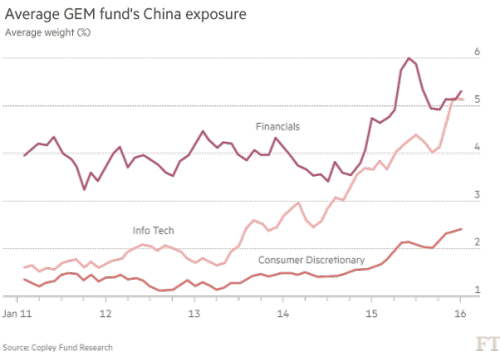Recently in asset management: many managers of emerging markets funds are dropping the old BRIC hypothesis and radically reduce the concentration of assets in commodity-heavy economies (primarily Russia and Brazil).
They are replaced by a grouping that the FT calls TICKs, focusing on technology-centric economies like Taiwan and South Korea. As one can see, it is not only a reallocation of fund investments towards tech-heavy economies, but also a shift of country-internal assets towards technology companies. In simpler words, technology companies take significant shares in individual country baskets.


While some argue, with some merit, that this reallocation is a cyclical response to the end of commodity super cycles, there is an interesting larger narrative here: the pairing of a structural coming-of-age of emerging markets with the digital age.
Emerging markets economies are migrating from production towards consumption.
While doing so, they are supercharged by the digital revolution. The effects are immense. On a larger scale, emerging economies now fully experience the effect of maturing consumer societies, even in commodity-centered countries. This is largely reminiscent of the industrialized world’s development in the past decades. Thriving middle classes bring with them the consumption of goods on an unprecedented scale. Standards, sensitivities and expectations have risen and helped to create large consumer-oriented companies.
However, the digital age gives this whole tale a new twist.
First, the dissemination of innovation and products in the digital age is instant. Likewise, the speed of customer adoption gets faster and faster. The explosive growth of the large digital technology companies in the emerging world is the result, which seems to have caught some EM asset managers by surprise.
Second, the digital economy is fundamentally consumer-centric. It breaks up information monopolies, disaggregates markets and creates immediate access. On top, software-ization supports an increasing degree of product individualization. Third, it does all of this on an international level, enabling EM companies to access global markets.
The result is a consumer society on steroids, and rampant growth of technology companies. The EM coming of age is happening in fast motion, it is digital and much, much more than a reaction to decreasing commodity booms. That is the true backstory of the Ticks.
For more business and finance tips, check our entrepreneurship and finance sections and subscribe to our weekly newsletters.






